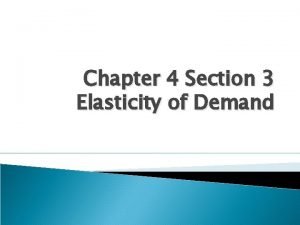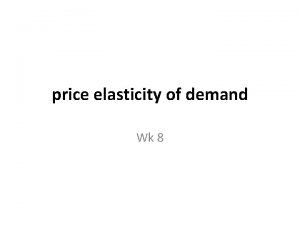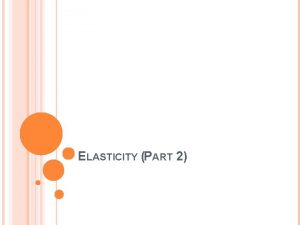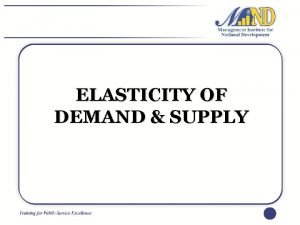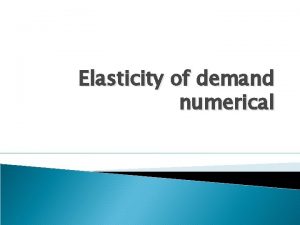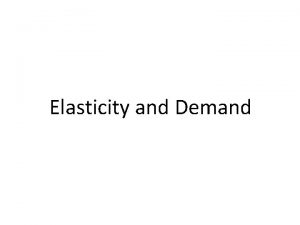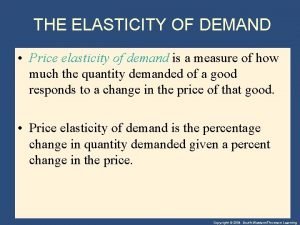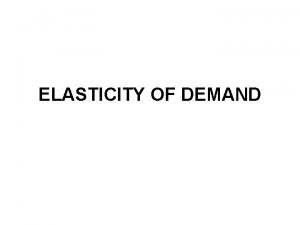Chapter 4 3 notes Demand Elasticity Demand Elasticity











- Slides: 11

Chapter 4. 3 notes Demand Elasticity

Demand Elasticity • • HOW MUCH a change in P causes a change in Qd Elastic – when a change in P causes a relatively larger change in Qd. Ex: green beans, corn, tomatoes, etc.

cont’d • • Inelastic – a change in P causes a relatively smaller change in the quantity demanded. Ex: table salt, gas Unit Elastic – a given change in price causes a proportional change in quantity demanded.

Calculating Demand Elasticity = %ΔQd %Δ P If the numerator is > denominator = elastic If the denominator is > numerator = inelastic

Total Expenditures Test • • TE= P x Qd If demand curve is elastic – when P down, TE up. (inverse) If the demand curve is inelastic – P down, TE down and vice versa If the demand curve is unit elastic – P down OR up and NO change in TE

Total Expenditure Price When the price is $4, consumers will demand 100 units, and spend $400 on this good. $4 P × Q = $400 (TE) P 0 Demand 100 Q Quantity

How TE Changes When Price Changes: Inelastic Demand Price An Increase in price from $1 to $3 … … leads to an Increase in TE from $100 to $240 $3 TE = $240 $1 Demand TE = $100 0 100 Quantity Demand 0 80 Quantity

How TE Changes When Price Changes: Elastic Demand Price An Increase in price from $4 to $5 … … leads to an decrease in TE from $200 to $100 $5 $4 Demand TE = $200 0 TE = $100 50 Quantity 0 20 Quantity Note that with each price increase, the Law of Demand still holds – an increase in price leads to a decrease in the quantity demanded. It is the change in TR that varies!

Determinants of D Elasticity • Necessities vs. Luxuries – Necessities usually inelastic • Substitutes goods/services - If no sub, usually inelastic • Portion of income – if uses a large portion of income, usually elastic

Rank the following items from most elastic to least elastic • • • Honda Accord Beef European vacation Salt Dijon mustard steak

Results…? • • • European Vacation Honda Accord Dijon mustard Steak Beef salt
 Chapter 4 section 3 elasticity of demand
Chapter 4 section 3 elasticity of demand Lesson 3 elasticity of demand answer key
Lesson 3 elasticity of demand answer key Chapter 4 section 3 elasticity of demand
Chapter 4 section 3 elasticity of demand Yed formula
Yed formula Formula for elasticity of demand
Formula for elasticity of demand Promotional elasticity of demand
Promotional elasticity of demand Advertising elasticity of demand
Advertising elasticity of demand Anna owns the sweet alps chocolate store
Anna owns the sweet alps chocolate store Yed. (80
Yed. (80 What are the 5 determinants of price elasticity of demand
What are the 5 determinants of price elasticity of demand Objectives of elasticity of demand
Objectives of elasticity of demand Numericals on elasticity of demand
Numericals on elasticity of demand


